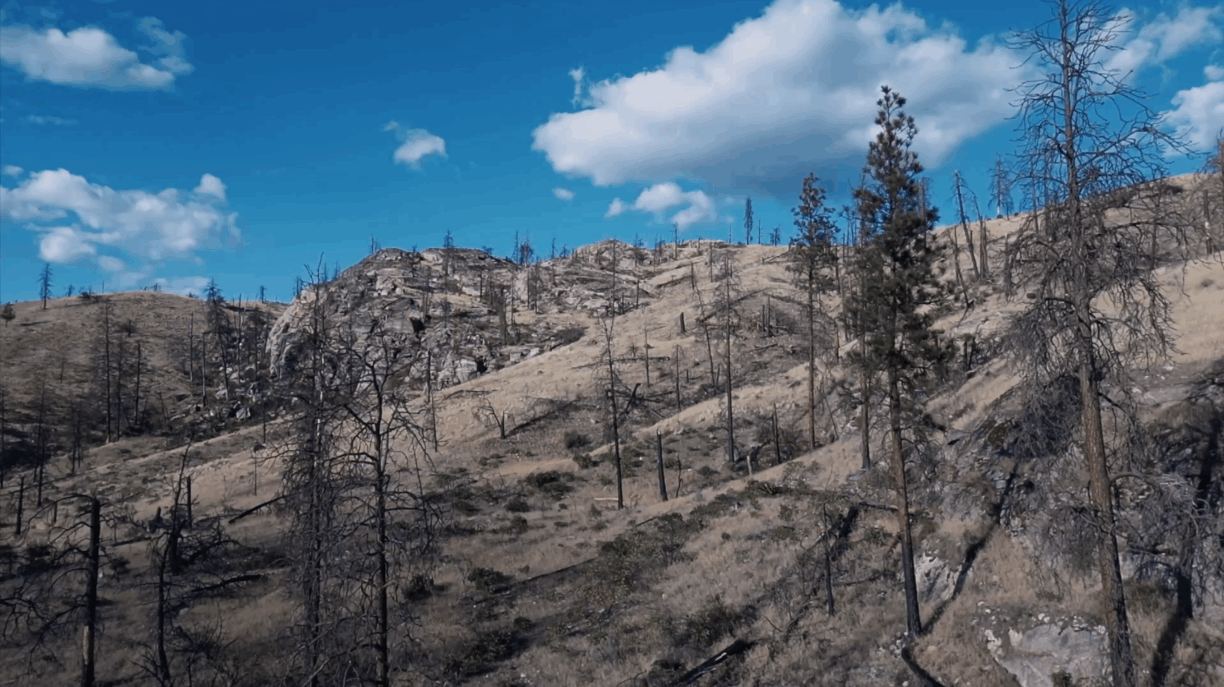- My Favorite Things –Andrew Forster
- My Favorite Things –Andrew Forster
- My Favorite Things –Andrew Forster
- My Favorite Things –Andrew Forster
My Favorite Things
Andrew Forster
6 April–
1 May 1993
Curated by: Susan Shuppli






My Favorite Things
Andrew Forster
Curated by: Susan Shuppli
The Or Gallery is proud to present visiting artist, Andrew Forster’s, audio/photo installation, My Favorite Things.
I’m thinking about my favourite things after having set up in the gallery. This is the second time I have shown this work and a few things have changed. The walls are painted ochre. The stories, on cards, are on ,~ small shelves, one on each of three walls. The wolves have moved into a cube in the middle of the room. The masking tape with writing is gone. The music (a recording of John Coltrane playing My Favorite Things triggered occasionally when viewers are in the gallery) is louder. I usually change the work in new shows and, to a certain extent, this is just a way to stay alive and inside the work, to keep it working. Here are some questions I’ve come to in thinking about this and other recent work. What is the relationship between the personal (what we might categorize as spiritual) and the social (what we might categorize as political) in my work? What is the relationship of narrative to experience? Can autobiographical elements relate to or communicate something which could be considered universal? What am I going to do? This last question seems crucial.
A story relates to a recent event in my life. My mother died last year, quite suddenly. I remember a moment of panic shortly after her death, a realization that mom ” ‘is not there anymore, and in this moment of panic a resonance with memories of childhood, times when the infinite security of a child’s existence is punctured by becoming lost, finding oneself alone. And along with this resonance of memory arises the question ‘what am I going to do now?’ for one will go on from here. Death comes close to everyone at some time. It is simultaneously the least unique and most unique of traumatic experiences. It caused me to dwell (this is the perfect word) on questions that seem basic to human existence, childish questions, questions which we categorize as spiritual because they deal with that which is, according to our epistemology, unknowable: What is a person? What is life? What is consciousness? What happens when you die? Then there is that other, equally persistent, question: What am I going to do now? What happens when you die? is a child’s question. What am I going to cW now? is not. It seems to occupy a transitional place. It is a recognition of the social yet it contains all these ‘childish’ questions about being.
To put it crudely, there are three things in this exhibition. There is the story about being lost, of losing mom. There is the story of the wolf. And there’s Coltrane playing My Favorite Things. How these elements are manifested and how they relate to each other is a matter of fascination for me. The wolf story is ‘true’, an encounter on Bathurst Island, NWT a couple of summers ago. In fact, all the stories on the cards my favourite things, 00 Gallery, Halifax, November, 1992 are true for me. But what is tantalizing is whether or not, and how, they are true for you. The choice of the second person for these few sentences on the business cards was originally simply (I thought), a way of avoiding both the alienating ‘I’ of the first person and the literary third person, becomes more complex. The flipping of the wolves to the cube in the centre of the room is, 1 think, related to tb.is shift. Can you stand in my place, experience what 1 have experienced, slip into my shoes? These are questions aboUt the possibility of expression or communication.
Looking at this as well as past work (such as water flowing effortlessly) there seems to be, along side the supposed ‘real’ content of the pieces, an attempt to manifest the clumsiness of my own efforts at communication or expression (or whatever it is, since neither of these terms suits me). All this earnest clumsiness in the face of some notion of communication ..or ‘art’ which seeks to erase this clumsiness, to hide it through technical proficiency, to transparently communicate that which needs to be communicated. 1 wonder if it is possible to go beyond both a model of expression which says, ‘I feel pain’ in a beaUtiful form which is read, simply, as a sign, an unburdening, and a model of rational communication, which assumes a mastery over what is to be communicated and how to do it (it’s interesting that in this century expressionism often poses as an antidote to technology and the rational communication model it engenders)-to find some other common ground in the space between us, both an expression and a reflection on the possibility of communication-a poetics.
On some level there is in my work an attempt to address a division berween the social and the spiritual. Somehow the work must act as a mirror of my own being in the world, one that is constantly adjusted and cleaned, refracting on different levels. At the same time 1 chose to play, to a certain extent, before others. What on earth can others see in my mirror? Many artists are working with literal, aUtobiographical content these days and such work opens itself to criticism for being narcissistic, nostalgic or so focussed on subjective detail that it does not allow any universalized response. Is work possible that is grounded in the individual but is also relevant on a social level (since the exhibition of art is a social activity)? Can one transcend this division berween subjective and social?
I was listening to an author on the radio who was discussing one aspect of this problem as it relates to writers of fiction. There is an enigma in that one must draw on ones own experience if one is to write with any ‘truth’ yet when one has a traumatic experience, which changes one’s life, one can, in attempting to write aboUt it, lose perspective and bog down in the description of the infinite details of an event which the writer sees as having great significance. The reader is alienated by an obscuring wall of unfathomable detail and impenetrable subjectivity. Hence fiction was better than aUtobiography. For me, this brings up a conundrum of narrative. Narrative is, of course, the first voice one reaches for when expressing one’s experience. It is a natural form, simulating lived experience-a series of events and details which occur over a period of time. The return to narrative (or personal narrative) in the visual arts can be characterized as a reaction to a feeling of alienation in relation to the modernist tradition in which the ‘personal’ was rarely perceived to be admitted. It is an attempt to be down to earth, to re-admit it into the work yet, in some ways, can be just as alienating, even reactionary. Perhaps this is when the exploration of identity or subjectivity ignores the intertwining of the personal and the social; the need to question and the need to be with the others.
the way it just worked and its ability to block out some things that were in the way. Over the years I have played it occasionally, maybe once one year, a couple of times the next, then not at all for five. When I think of it, it is one of the few pieces of music that I really stop to listen to, intently, disappearing into it, not playing along, not singing, or doing the dishes or whatever, just there. But the music always changing, expanding, growing, laid out possibilities that never occurred to me the times before, let alone as a teenager. Whether these possibilities are resident in me or in the music is a question whose answer would probably clarify some of my questioning here.
I first heard John Coltrane’s version of My Favorite Things, the version recorded live in 1963 with Roy Haynes on drums, when I was beginning university. It was the first Coltrane record I had, and for a long time the only one. In my room in residence I was painting and, for the first time, really sailing. I never gave the music much thought at the time, I liked the disorder,
My Favorite Things was a tune Coltrane used over and over as a base for explorations on soprano saxophone. In part, what I like about the many recordings of the song is how, starting from a simple pop melody (which is like a simple narrative) things gradually disintegrate and soar into extraordinary places, at the same time holding to a tried and true jazz structure. What soars in Coltrane’s My Favorite Things seems to me to be what is in between the recognizable elements (the tune, the structure) in an area that is undefinable, poetic and wondrous. Coltrane’s music is o&en less formally innovative than other big names of free jazz (Davis, Coleman, etc.) but for me his playing seems to embody a poetry or spirit that is as compelling as it is undefinable. What is compelling exists oUtside (or between) the space defined by formal innovation or traditional structure, yet is dependent on the two. Asked by an interviewer (I read this on an album cover-maybe its not true) what his music was ultimately about, Coltrane replied that it was about getting to the crux of life through the process of the music. ”And what do you do when you get there?”, was the next question. “Well, you just keep going.”
Going back to the question of the possibility of approaching some universal, I know lots of people who can’t stand John Coltrane and others who find this music profound. So I don’t know. Perhaps it is the term universal that is the problem. Perhaps there is some limited universality, lets call it some relevance, based on an intimacy with common cultural forms at the same time dependent on pushing those forms to express the inexpressible. There does seem to be some common territory to be traced out in between the elements and some need to do so.
– AF
My Favorite Things by Andrew Forster (722.26 KB)
Artist Bio
Andrew Forster
Andrew Forster is an artist and writer living in Montreal. My Favourite Things was Andrew’s first solo exhibition in Vancouver.



